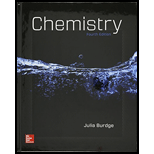
Concept explainers
Interpretation:
The moleculargeometry for each given species, using VSEPR, is to be determined.
Concept introduction:
The VSEPR theory is used to predict the geometry of the molecules using the number of electron pairs surrounding the central atom.
There is a repulsive force acting between the electron pairs of the molecule, which leads to instability. Hence, the electron pairs around the central atom in a covalent molecule arrange themselves in a way to minimize this repulsion and become stable.
If the molecule has two bonding electron pairs and three nonbonding electron pairs. This forms geometry of type
If the molecule has four bonding electron pairs and zero nonbonding electron pairs. This forms the geometry of type
If the molecule has five bonding electron pairs and zero nonbonding electron pairs. This forms the geometry of type
If the molecule has four bonding electron pairs and one nonbonding electron pair, This forms the geometry of type
Want to see the full answer?
Check out a sample textbook solution
Chapter 24 Solutions
Chemistry - With Access
- What is the hybridization of the selenium atom in SeF4?arrow_forwardHow do the electron domains about P in P4O6 differ from those about P in P4O10?arrow_forwardDescribe the hybridization of silicon and the molecular structure of the following molecules and ions:(a) (CH3)3SiH(b) SiO44−(c) Si2H6(d) Si(OH)4(e) SiF62−arrow_forward
- What is the hybridisation of S in SF6 ?arrow_forwardDraw the structure of PCL5 Calculate their hybridization and also determines the shapes and geometriesarrow_forwardDraw the Lewis structure of phosphate (PO₄³⁻) by following the octet rule on all atoms and then determine the hybridization of the central atom.arrow_forward
- What is the state of hybridization of boron and oxygen atoms in boric acid?arrow_forwardWhat atomic or hybrid orbitals make up the bond between C and O in carbon dioxide, CO2 ?arrow_forwardPlease explain the scientific method with few words and write the lewis structure of PCl3, then indicate the molecular geometry of the molecule according to VSEPR and indicate the hybridization type of the structurearrow_forward
 Chemistry: The Molecular ScienceChemistryISBN:9781285199047Author:John W. Moore, Conrad L. StanitskiPublisher:Cengage Learning
Chemistry: The Molecular ScienceChemistryISBN:9781285199047Author:John W. Moore, Conrad L. StanitskiPublisher:Cengage Learning Chemistry: Principles and PracticeChemistryISBN:9780534420123Author:Daniel L. Reger, Scott R. Goode, David W. Ball, Edward MercerPublisher:Cengage Learning
Chemistry: Principles and PracticeChemistryISBN:9780534420123Author:Daniel L. Reger, Scott R. Goode, David W. Ball, Edward MercerPublisher:Cengage Learning Chemistry & Chemical ReactivityChemistryISBN:9781337399074Author:John C. Kotz, Paul M. Treichel, John Townsend, David TreichelPublisher:Cengage Learning
Chemistry & Chemical ReactivityChemistryISBN:9781337399074Author:John C. Kotz, Paul M. Treichel, John Townsend, David TreichelPublisher:Cengage Learning Chemistry & Chemical ReactivityChemistryISBN:9781133949640Author:John C. Kotz, Paul M. Treichel, John Townsend, David TreichelPublisher:Cengage Learning
Chemistry & Chemical ReactivityChemistryISBN:9781133949640Author:John C. Kotz, Paul M. Treichel, John Townsend, David TreichelPublisher:Cengage Learning



